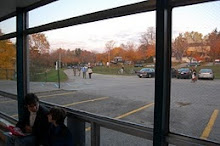 Yesterday I had the opportunity to spend the day in LSR’s lab in Cedarberg, WI working with their CTO, Brian Petted, on a physical layer issue in an 802.11 card. LSR’s has equipment that can pull out the modulation and display constellation diagram of digital signals and measure properties of the carrier.
Yesterday I had the opportunity to spend the day in LSR’s lab in Cedarberg, WI working with their CTO, Brian Petted, on a physical layer issue in an 802.11 card. LSR’s has equipment that can pull out the modulation and display constellation diagram of digital signals and measure properties of the carrier.My mission was to compare some 802.11b radios with performance issues to those that worked normally. Both radios met the 802.11b spec, but one had a much tighter constellation diagram than the other . (Yes, 802.11b is ancient, but this client has products with long industrial product life cycles.)
Good radio:

Bad radio:

The screenshots above contain loads of good info.
EVM[peak] – Average noise on the symbols, i.e. how much the constellation points spread out.
EVM[peak] – How far the worst outlier symbol lies from the median.
RMS Phase Noise – This is noise on the carrier itself.
It turned out the problem with the bad radio was that signal from the modulator was getting into the LO and causing phase noise in the carrier. Once there is phase noise on the carrier, you naturally have phase noise on the received symbols. Brian Petted worked out all of that without even removing the shield and probing the stages of the circuit.
It is very interesting that the 802.11b spec is so permissive. It allows huge symbol EVM, but compliant receivers do better if your transmitter has a nice tight constellation diagram.
Another interesting thing I found was that some radios I tested showed large side-lobes, approaching the limit mask, but worked fine in their application. Large side lobes seen on a spectrum analyzer can often indicate a problem, but sometimes they just mean a larger modulation index, which does not necessarily cause problems.
Usually when I’m testing wireless equipment, I have to work out what’s going on based on performance, usually PER vs SNR. I make hypotheses being careful not to tell them shape future observations; I can’t lose sight of the fact I don’t really know what’s going on at the physical layer. So it was amazing for me to spend some time in a lab with high-end equipment and a communications theory expert. I got insights that I never could have worked out sitting in my lab with a just scope, spectrum analyzer, and a WiFi sniffer.
I am always in awe when I dig into high-speed digital modulation because the technology completely blows away my wildest childhood geek-dreams I had back when I used a 2400bps landline modem and wireless digital modulation meant RTTY on shortwave or numeric pagers on VHF.


No comments:
Post a Comment